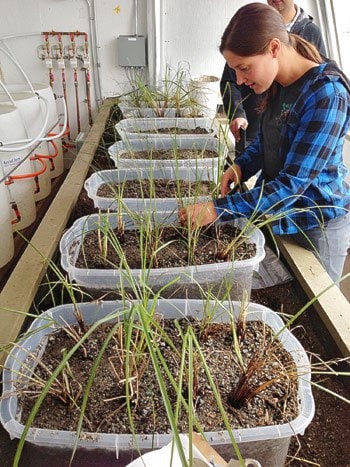Tall grasses, squelchy soil, the stale smell of stagnant water - to most of us, swamps and marshes may not seem like the most pleasant places.
But these wetlands could be the key to cleaning contaminated water from Yukon’s mines cheaply and easily.
Scientists at the Yukon Research Centre have found that man-made wetlands can remove up to 99 per cent of heavy metals from mine drainage water.
They conducted the experiment by running simulated mine water contaminated with copper, selenium, cadmium, and zinc through eight Rubbermaid containers filled with sand, gravel, and transplanted wetland plants.
They found that the water flowing out of the containers contained almost no heavy metals.
“I was expecting the wetlands to work well, but it was beyond what we expected,” said Dr. Amelie Janin, the NSERC Industrial Research Chair in mine life cycles at Yukon College. “What nature does is just amazing. It’s so powerful.”
The process depends not on the plants, but on bacteria that live in wetlands. These bacteria breathe sulfate instead of oxygen, and they expel a compound called sulfide as waste.
That sulfide binds to heavy metals dissolved in water. It causes them to form solids that sink out of the water and settle into the soil beneath, where they’re essentially harmless.
Janin said contaminated mine water is typically held in tailings ponds or cleaned in water treatment plants. But the advantage of constructed wetlands is that they don’t require much infrastructure or oversight.
“A wetland is very appropriate for the closure of a mine,” said Janin. “(It) doesn’t take anything.”
The project was partly funded by Casino Mining Corp., which has proposed a constructed wetland as part of its closure plan.
The researchers also found that the vast majority of the metals they tested stayed in the soil and didn’t migrate up into the roots or leaves of the wetland plants. Plants contaminated with heavy metals could pose a threat to wildlife.
Still, wetlands may not seem like an obvious choice in a region where the ground is frozen for half the year. Janin said there has been little research looking at how well constructed wetlands will work in cold temperatures.
But Andre Sobolewski, a consultant with 20 years of experience building constructed wetlands, believes they could be more useful in the Yukon than they are further south. He was a consultant for Casino during this research project.
Sobolewski said bacteria adapted to cold climates are active even in the winter, meaning the wetlands could treat water all year round.
And there is some dramatic evidence to support this. In 1936, a three-ton copper nugget was found beneath a wetland in Alaska. Sobolewski said it was formed from copper leaching into the water from nearby rocks and reacting with sulfide - the exact same process that occurs in constructed wetlands.
In the North, Sobolewski said, water treatment plants may well be less reliable than wetlands.
“There’s more likelihood of mechanical failure in the Yukon, just because of the climate,” he said. “Ecosystems tend to be adapted, but get your truck frozen one cold morning, and you know that mechanical failure is real.”
He said the biggest obstacle for constructed wetlands in the Yukon is people, not technology.
“People are very skeptical,” he said, adding that Yukon’s mining industry has a history of “make a mess and leave it.”
Still, constructed wetlands are not common in Canada, let alone in the North. Sobolewski estimates there are about 20 man-made wetlands currently operating at mine sites in Canada, compared to roughly 500 in the U.S.
But he said that has more to do with history than climate. Constructed wetlands have become a popular, low-cost option for cleaning up abandoned coal mines in Appalachia and gold mines in the West. Canada doesn’t have that same number of abandoned, contaminated mine sites.
Despite Sobolewski’s optimism, there’s still more work to be done before constructed wetlands become a reality in the Yukon. The next step for Janin and her team is to conduct larger-scale experiments, using more plant species.
Contact Maura Forrest at
maura.forrest@yukon-news.com
